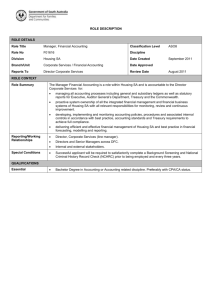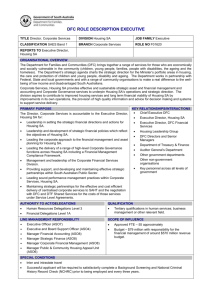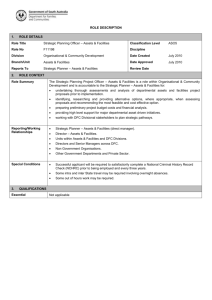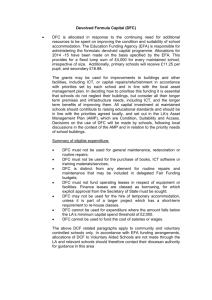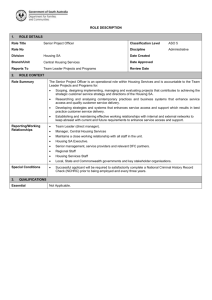2. Stochastic simulation
advertisement
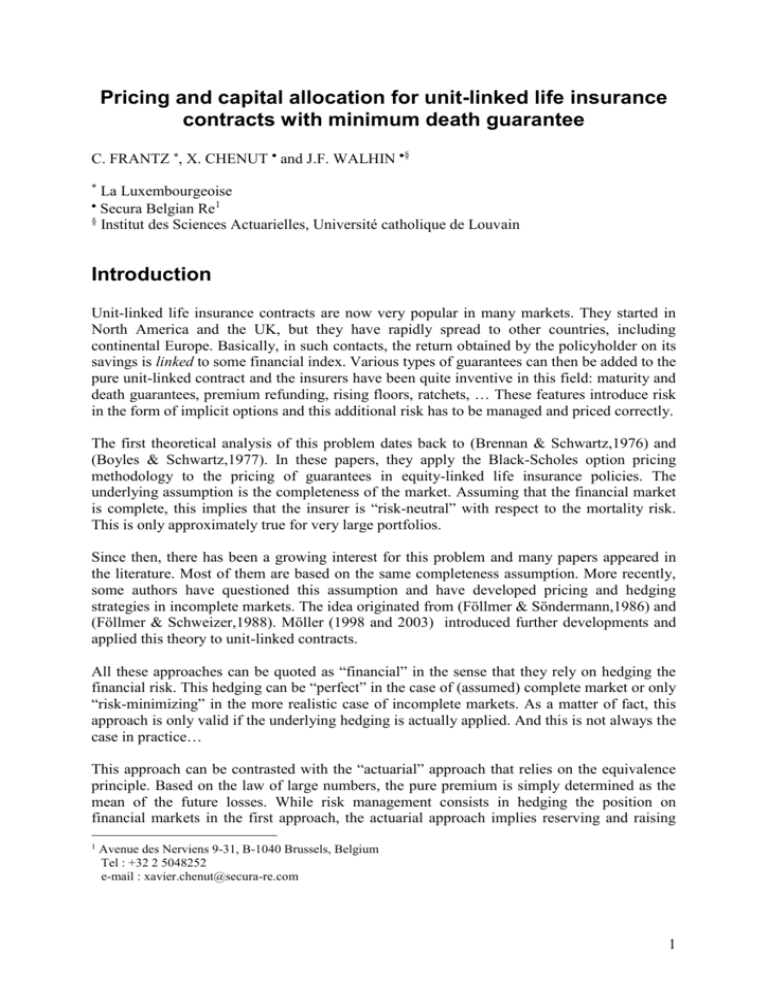
Pricing and capital allocation for unit-linked life insurance contracts with minimum death guarantee C. FRANTZ , X. CHENUT and J.F. WALHIN § * La Luxembourgeoise Secura Belgian Re1 § Institut des Sciences Actuarielles, Université catholique de Louvain Introduction Unit-linked life insurance contracts are now very popular in many markets. They started in North America and the UK, but they have rapidly spread to other countries, including continental Europe. Basically, in such contacts, the return obtained by the policyholder on its savings is linked to some financial index. Various types of guarantees can then be added to the pure unit-linked contract and the insurers have been quite inventive in this field: maturity and death guarantees, premium refunding, rising floors, ratchets, … These features introduce risk in the form of implicit options and this additional risk has to be managed and priced correctly. The first theoretical analysis of this problem dates back to (Brennan & Schwartz,1976) and (Boyles & Schwartz,1977). In these papers, they apply the Black-Scholes option pricing methodology to the pricing of guarantees in equity-linked life insurance policies. The underlying assumption is the completeness of the market. Assuming that the financial market is complete, this implies that the insurer is “risk-neutral” with respect to the mortality risk. This is only approximately true for very large portfolios. Since then, there has been a growing interest for this problem and many papers appeared in the literature. Most of them are based on the same completeness assumption. More recently, some authors have questioned this assumption and have developed pricing and hedging strategies in incomplete markets. The idea originated from (Föllmer & Söndermann,1986) and (Föllmer & Schweizer,1988). Möller (1998 and 2003) introduced further developments and applied this theory to unit-linked contracts. All these approaches can be quoted as “financial” in the sense that they rely on hedging the financial risk. This hedging can be “perfect” in the case of (assumed) complete market or only “risk-minimizing” in the more realistic case of incomplete markets. As a matter of fact, this approach is only valid if the underlying hedging is actually applied. And this is not always the case in practice… This approach can be contrasted with the “actuarial” approach that relies on the equivalence principle. Based on the law of large numbers, the pure premium is simply determined as the mean of the future losses. While risk management consists in hedging the position on financial markets in the first approach, the actuarial approach implies reserving and raising 1 Avenue des Nerviens 9-31, B-1040 Brussels, Belgium Tel : +32 2 5048252 e-mail : xavier.chenut@secura-re.com 1 capital in order to cover the future losses with a given probability. Since the financial risk is not completely diversifiable, this usually gives rise to large capital costs. The actuarial approach also received some attention in the literature, for example in papers by Hardy in which both approaches are contrasted regarding reserving and risk management using Monte Carlo simulations (Hardy, 2000 and 2002). In this paper, we shall concentrate on the minimum death benefit guarantee. In this case, the insurer’s liability for a death at time t will be: max(K, St)= St + max(K-St,0) where max(K-St,0) corresponds to the sum at risk and is similar to the terminal cash-flow of a european put option with strike price K. It is so that some insurers prefer not to bear this risk and, as a reinsurer, we were asked for a protection of the sum at risk for such unit-linked contracts. In this case, the insurer leaves 100% of the risk to its reinsurer that has to manage this risk and ask for a “correct” price for taking it. That is the problem we faced and this paper tries to solve it, or at least answer some questions it raised. The first question is: should we use the financial or the actuarial approach to price this cover? This is a crucial question as the “pure” prices obtained according to each approach can be quite different. This is easily explained by the fact that, in both approaches, the famous Black-Scholes put pricing formula can be used. But the difference between the two types of pricing is that the actuarial one is obtained under the physical probability measure P and the financial one under the risk-neutral measure Q. Whatever under P or Q, we use the Black-Scholes formula to obtain a pure premium corresponding to the average of the Discounted Future Costs (DFC). With this premium we do not know anything about the standard deviation of the DFC or more generally about their distribution. This could be very dangerous considering the actual fluctuations of the financial markets. Regarding the standard deviation of the DFC, we can easily imagine that the one resulting from the actuarial pricing is larger than its financial counterpart, mainly because of the assumed hedging strategy applied on the financial markets when we are under the probability measure Q. To answer this question concerning the standard deviation and to compare the actuarial and the financial prices, we proceed to stochastic simulation of two elements: the underlying asset St and the death process Nt of a cohort of Bt insured persons at time t. Mainly for applicability reasons, at least at the reinsurer level, we eventually have to go for the actuarial approach. At the end of this step we obtain a Single Pure Premium (SPP) but the risk still has to be reflected in the price. And here comes the second question: based on the loss distribution obtained, how to fix the price? A cash-flow model is built to answer this question. This model includes capital allocation during the whole “life” of the contract - this capital is equivalent to a solvency margin. This finally raises the question of the amount of capital needed. This difficult question still does not have a definitive answer in the literature, particularly for a multi-periodic setting as the one we face here. 1. Actuarial versus financial pricing The actuarial and the financial approaches are in opposition by the way of tackling the question. 2 The financer will say that the unit-linked life insurance contract with minimum death guarantee is a contingent claim. He will therefore use a hedging argument to determine the price of such a contract. In our case (the guarantee K does not depend on t), the insurer’s liability for a death at time t is similar to the terminal cash-flow of a European put option and we end up with a Black-Scholes like put pricing formula (under the risk-neutral measure Q). We will see that the equivalence principle or actuarial approach brings the same type of formula (except that we are under the physical probability measure P) but the way of analysing the problem is completely different. The actuary doesn’t want to duplicate the flows of a financial instrument; by applying the equivalence principle, he will determine the single pure premium by evaluating the average of the future losses. The first question to be answered is then: should we use the financial or the actuarial approach to price this cover? a. The underlying asset We assume that the underlying asset of our contract follows a classical geometric Brownian motion, described by the following stochastic differential equation under the physical P measure: dS t S t dt S t dWt , (1) with the unique solution S t S 0 . exp ( 2 / 2)t Wt . (2) Applying Girsanov’s theorem, the asset price can be shown to follow the following process under the risk-neutral probability measure Q: ~ dS t rS t dt S t dWt (3) with the unique solution ~ St S 0 . exp (r 2 / 2)t Wt , (4) where: St is the price of the underlying asset at time t, is the expected rate of return of the underlying asset and its standard deviation, ~ Wt is a standard Brownian motion under the P measure and Wt a standard Brownian motion under Q. Here and throughout the paper, we make the hypotheses that the financial market is complete and arbitrage-free and that the risk-free interest rate r is constant. 3 Now we have a description of the financial market, we would like to express the price of our contingent claim (financial approach terminology) and the future losses (actuarial approach terminology) in this setting. b. Expected loss in t for a death in T We know, using (2) and (4), that ST law St log N ( 2 / 2)(T t ), 2 (T t ) , P (5) ST law St log N (r 2 / 2)(T t ), 2 (T t ) . Q (6) This means that the return of the asset follows a log-normal distribution with parameters (2/2)(T-t) and 2(T-t) under the physical P measure of probability and a log-normal distribution with parameters (r-2/2)(T-t) and 2(T-t) under the risk-neutral Q measure of probability. Given (5) and (6) we can now evaluate the expected loss in t for a death in T according to each type of pricing. Thus we define: V P (t , T ) EP e r (T t ) max( K ST ,0) t , and V Q (t , T ) EQ e r (T t ) max( K ST ,0) t , where the filtration t represents all the information generated by the evolution of the asset price and the mortality up to time t. The difference between the two formulas lies in the expected rate of return of the underlying asset under each probability measure: under the P-measure for the actuarial approach, r under the Q-measure for the financial approach. But it is important to remind that the financial pricing approach relies on the assumption that a defined hedging strategy in the financial market is applied. Otherwise, the price obtained is meaningless. This last remark is crucial. Indeed, this is certainly a practical disadvantage of the financial approach. Intuitively, this however also leads to some advantages over the actuarial approach: 4 the premium is independent of the expected rate of return of the underlying asset whereas the actuarial premium could be affected by errors in its estimation, most of the financial risk is eliminated through the hedging portfolio; the remaining financial risk is due to the fact that the mortality risk is never completely diversified. c. Single Pure Premium We obtain an expression for the single pure premium SPP according to each type of pricing. x SPP Act V P (0, k ) k p x q x k k 1 T T k 1 k 1 Ke rk (d 2Act (0, k )) k p x q x k S 0 e ( r ) k (d1Act (0, k )) k p x q x k (7) x SPP Fi V Q (0, k ) k p x q x k k 1 T T k 1 k 1 Ke rk (d 2Fi (0, k )) k p x q x k S 0 (d1Fi (0, k )) k p x q x k (8) where: d 2Act (t , T ) log( S t / K ) (r 2 / 2)(T t ) T t Act Act d1 (t , T ) d 2 (t , T ) T t and d 2Fi (t , T ) log( S t / K ) ( 2 / 2)(T t ) T t d (t , T ) d (t , T ) T t Fi 1 Fi 2 We verify that the two formulas look quite similar. The financial premium is nothing else but a sum of Black-Scholes put prices and the actuarial premium has the same form. Only the risk-free rate r is replaced by the expected return . As pointed out in (Devolder,1993), this unavoidably leads to higher financial pure premiums as soon as > r. In order to further compare both approaches, we are not only interested in the pure premiums (that is, the expected discounted future costs DFC), but also in the whole probability distribution of the discounted losses. This can only be done using Monte Carlo simulations. 5 2. Stochastic simulation As we want to obtain the distribution of the DFC, we need to simulate the value of the underlying asset and the death process. In order to keep the expressions simple, we shall make the hypothesis that the sum at risk is the same for each insured person. This assumption can easily be relaxed. a. Simulation methodology 1. The underlying asset We use a basic methodology to simulate the underlying asset. We fix a time step t and approximate the stochastic differential equation (1) at time nt by: X 0 S 0 X n 1 X n (1 t t ) where has a standard normal distribution. 2. The death process If we consider a cohort of Bt insured persons of age x at time t, we can show that the random variable Yt counting the number of deaths in this cohort between t and t+1 follows a binomial distribution with parameters Bt and qx+t. b. Adaptation of each approach to stochastic simulation 1. Actuarial approach For the simulation i and the insured j, the amount to be paid in time t is: M t(i , j ) ( K S t(i ) ).1S ( i ) K T ( i ) t (t ) , t x( j ) where Tx((i )j ) is the time to death of the jth person (aged x(j)) in simulation i. In order to obtain a realisation of the random variable DFCAct, we only have to sum up the discounted realisations Mt(i,j) over the time t and the B0 insured persons. An estimation of the single pure premium is then obtained by averaging over the N simulations: 6 SPP Act 1 NB0 N B0 T e i 1 k 1 j 1 rk M k(i , j ) . 2. Financial approach The financial approach is somewhat more difficult to adapt than the actuarial one because we have to reflect the impact of the hedging strategy in the price of the contract. We first define the cost of re-hedging of the underlying risky asset and the risk free asset at time t (this amount can be positive or negative): ~ ~ ~ G (r , t , S t , t ) e rt S t ( t t 1 ) G (r, t ,~t ) e rt (~t ~t 1e r ) ~ where t (T ) is the quantity of underlying risky asset and ~t (T) the amount of risk-free asset held at time t. We can prove that: ~ (T ) t B0 ( k ) j 1 k t 1 B0 ~ B0 T T t k p x ( j ) q x ( j ) k K T e j 1 k t 1 B0 r ( k t ) (d 2Fi (t , k )) k p x ( j ) q x ( j ) k T t (T ) t (k ) k p x ( j ) q x ( j ) k (d1Fi (t , k )) k p x ( j ) q x ( j ) k . j 1 k t 1 j 1 k t 1 The coefficients t(k) and t(k) represent respectively the quantity of risky and risk-free asset that is necessary at time t to duplicate the terminal flows of a European put option of price K and maturity k. ~ The process ~t Τ , t Τ t T corresponds to the number of assets to be held at t to duplicate the flows generated by our contract (that ends in T). This is in fact the sum of the duplication coefficients of a traditional European put option weighted by the mortality densities at ages x(j). This hedging strategy (as well as the corresponding pricing formula (8)) relies on the assumption that the insurer is “risk-neutral” with respect to the mortality risk, that is that he holds a sufficiently large portfolio. A realisation of the random variable DCFFi is obtained by summing the discounted mortality and hedging costs. We finally obtain an estimation of SPPFi by averaging: T B0 rt (i , j ) (i ) (i ) ~ (i ) (i ) ~ (i ) ~ (i ) ~ (i ) (i ) e M k G (r , k , S k , k ) G (r , k , k ) 0 0 S 0 i 1 k 1 j 1 1 N T ~ ( i ) rk (i ) k (e S k e r ( k 1) S k( i)1 ) SPP Act . NB0 k i k 1 SPP Fi 1 NB0 N 7 c. Results All the results presented hereunder were obtained under the following hypotheses: S0 = 1, K = 1, = 8.5%, = 25%, r = 5%, 1,000 insured persons aged 45, 10,000 simulations. 1. Probability distribution functions The following graphs show the distribution of the DFC obtained respectively using the actuarial and the financial approaches. Distribution of DFCAct Distribution of DFCFi 1 1 0,8 0,8 0,6 0,6 0,4 0,4 0,2 0,2 0 0 0 5 10 15 20 DFC 25 30 35 40 Act 0 5 10 15 20 25 30 35 40 DFCFI We can observe that the actuarial approach results in a very dispersed distribution of the DFC in comparison with the financial approach. In the financial case, we are tending to the probability distribution of a classical death benefit cover. This comes from the fact that the DFCAct are very sensitive to a small fluctuation of the underlying asset whereas almost all the financial risk has been removed by hedging in the financial approach (note that not all the financial risk is eliminated because the mortality is random and we are not completely “riskneutral” with respect to mortality risk, so that the hedging cannot be perfect). 2. Sensitivity analysis When doing stochastic simulations to estimate the distribution of the DFC, we fixed several parameters like the risk-free rate r, the expected rate of return , the volatility . The distribution of the DFC is a function of all these parameters. They are however not perfectly known and are subject to estimation errors. The aim of this section is to test the sensitivity of the DFC distribution to these parameters in both approaches. We shall restrict ourselves here to the expected return and volatility of the underlying asset. 8 With respect to Distribution of DFCAct - variation of 1,00 20% 15% 0,80 10% 8,5% 5% 0,60 0% -5% -10% 0,40 -15% -20% No Stock 0,20 0,00 0 10 20 30 40 Act DFC Distribution of DFC 50 Fi 60 70 80 - variation of - 1 0,8 0,6 FI -10% 0,4 -5% 0% 5% 8,50% 0,2 10% 15% 20% 0 6 7 8 9 10 DFC Fi 11 12 13 14 Sensitivity to 5% 10% 15% 20% 25% 30% 35% 40% Actuarial approach Mean Standard deviation 44,15 12,46 34,04 16,13 21,18 16,81 9,94 12,93 5,04 9,04 3,51 7,28 1,22 3,57 0,42 1,42 Financial approach Mean Standard deviation 10,45 4,11 10,40 3,49 10,26 2,71 10,16 1,99 10,10 1,60 10,12 1,45 10,17 1,10 10,20 0,92 9 As expected, the financial premium (mean of DFCFi) is nearly independent of whereas the actuarial premium increases with the expected return and is very sensitive to this parameter. The more decreases, the more SPPAct increases. When becomes negative, the shape of the distribution of the DFCAct tends to the shape of a classical death insurance (without any financial component). The variance of the DFCAct reaches its maximum for = 0 because, in this case, the price of the underlying asset oscillates around S0 (= K, the amount of the minimum death guarantee). Even in the financial approach, the shape of the distribution is affected. It is more and more centred around its mean as increases. With respect to Distribution of DFC Act - variation of - 1,00 5% 0,80 10% 15% 20% 0,60 25% 30% 35% 0,40 40% No Stock 0,20 0,00 0 10 20 30 40Act DFC 50 60 70 80 Fi Distribution of DFC - variation of 1 0,8 0,6 5% 10% 0,4 15% 20% 25% 0,2 30% 35% 40% 0 0 10 5 10 15 DFC Fi 20 25 30 Sensitivity to 5% 10% 15% 20% 25% 30% 35% 40% Actuarial approach Mean Standard deviation 0,01 0,02 0,11 0,40 0,71 2,21 2,46 5,64 5,11 9,22 8,94 12,77 13,17 15,88 17,64 18,28 Financial approach Mean Standard deviation 0,03 0,02 0,63 0,17 2,75 0,57 6,10 1,07 10,14 1,61 14,47 2,19 18,90 2,65 23,24 3,14 We see that the DFC distribution is influenced by in both approaches. The mean as well as the variance of the DFC are increasing with the volatility of the underlying asset. The variance is however much less sensitive in the financial approach. d. Conclusion As a matter of fact, these results plead in favor of the financial approach. However, it implies that the underlying hedging strategy must be followed and this is not always desirable or even feasible in practice, at least for the reinsurer. Passive hedging is not possible since the corresponding put options are hardly found (mainly due to the very long maturities involved). Active hedging implies constant rebalancing of the hedging portfolio and could result in high costs. Moreover, it is so that the underlying index is not always precisely defined, at least at the reinsurer level, so that a perfect hedging is never possible. As a consequence, the reinsurer ends up with the conclusion that he can hardly put the financial approach into practice and that he finally has to resort to actuarial pricing. And here comes the second question: based on the loss distribution obtained, how to fix the price? The answer we suggest is based on a cash-flow model and is developed in the next section. 3. Cash-flow model In section 1, we obtained an expression for the single pure premium SPPAct. In section 2, the distribution of the discounted future costs DFC was estimated and the SPPAct is nothing else but the mean of this distribution. We now want to determine what is the price the (re)insurer should ask in practice for this cover (leaving aside management expenses). We shall call it here the Technico-Financial Premium TFP. The loading applied with respect to the pure premium should depend in some way on the “riskiness” of the cover. We propose here to consider the underwriting of this contract as an investment by the shareholders and to build a cash-flow model similar to what is used in evaluating any investment decision. Our simulation process provides us with the distribution of the DFC at each time t (as viewed from time 0 and not from time t), and this is all we need to determine the various cash-flows (including capital allocation) involved. 11 a. Cash-flows Hypotheses: We assume the capital is invested in stocks and bonds. The proportion of stocks in this investment portfolio is denoted by p. It is assumed that the technical provisions are invested in bonds only. The bonds are considered to be risk-free and to earn the risk-free interest rate. We further define some parameters: is the corporate tax rate, is the mean rate of return on the stocks, r is the risk-free rate. Outflows: net mean claim payments: ct (1 ) , where ct 1t 0 (t ) NB0 N B0 ( K S i 1 j 1 (i ) t ).1S ( i ) K T ( i ) t (t ) , t x( j) net mean change in technical provisions: pt (1 ) , where T pt 1t T (t ) e r ( k t ) c k , k t 1 mean change of allocated capital: k t . Inflows: net mean return on the provisions: Rt ( p)(1 ) , where Rt ( p) 1t 0 pt 1 (e r 1) , net mean return on the capital invested in bonds: Rt (k )(1 ) , where Rt (k ) 1t 0 kt 1 (e r 1)(1 p) , mean return on the capital invested in stocks2: Rt (k , ) , where Rt (k , ) 1t 0 kt 1 (e 1) p , 2 Note that, under the Belgian taxation system, the capital gains on stocks are not taxable, so that the tax on stock returns are small compared to tax on bonds returns. We assumed here that the returns on stocks are not taxable at all. 12 net premium income : TFP(1 ) , where the technico-financial premium TFP has to be determined. b. Evaluation of TFP In order to obtain the estimation of the TFP, we apply the net present value criteria and solve the following equation for TFP: T TFP(1 ) e t (COC ) ct (1 ) (pt Rt ( p))(1 ) k t Rt (k , ) Rt (k )(1 ) 0 , t 0 where COC stands for the cost of capital and is the return required by the shareholder on this type of business. We can easily show that the first two terms in the brackets are equal and the solution is then given by: T TFP e t 0 t ( COC ) k t Rt (k , ) Rt (k )(1 ) 1 . The way to obtain the solution is fairly simple because the premium is unique. This premium takes into account the mean level of the DFC at each time t viewed from 0 and the mean level of the capital that has to be allocated at time t for this business. Everything looks good since we got an expression for the price but we still face two important problems that were left aside up to now: How much capital should we allocate to this business and how to release it? What is the COC? These are open questions for which we do not have a satisfactory answer yet. In the following sections, we briefly explain how we handled these problems but further discussions and developments are undoubtedly needed. c. Risk measures and capital allocation All the insurance companies have liabilities and therefore they set up technical provisions calculated with prudential hypotheses. Nevertheless, insurance is still a risky business and the technical provisions can prove to be insufficient. Shareholders capital is needed to face this kind of unexpected event. We want now to evaluate the capital (or solvency margin) that is needed to underwrite this type of risk. It seems clear that the solvency margin depends on the “riskiness” of the product. This means that a pure death insurance does not need an amount of capital as large as a death guarantee in a unit-linked product. Several risk measures have been proposed to evaluate this riskiness. Axioms for a so-called coherent risk measures have been introduced in (Artzner et al., 1998) and various coherent risk measures do exist. 13 In this paper, we decided to use a risk measure that has become very popular in the last years: Conditional Tail Expectation. We define the conditional tail expectation of threshold for the random variable X as: CTE ( X ) [ X X V ( X )] where Vα ( X ) inf V : X V corresponds to the “Value At Risk” of level . Using the distribution of the discounted future costs at each time t, we define the capital to be allocated at time t as: k t CTE ( DFCt ) pt . This is only a possibility and many questions remain regarding the risk measure to adopt and the risk threshold to consider (parameter ). Another crucial problem comes from the multiperiodic nature of this insurance contract. Up to now, risk measures were considering only one-period risks. The difference mainly comes from the possibility of intermediate actions during the development of the risk. This problem was addressed only recently (Artzner et al., 2002) and we hope to have an answer to this question in a near future. Here we applied the one-period risk measure to the distribution of the total future losses at each time t. But is it necessary for an insurance company to have from the start of the contract an amount of capital that is sufficient to cover losses that will be spread over many years? Considering that the company can raise more capital in the next years if things go wrong, should the capital only allow the insurance company to pay the losses and set up sufficient provisions in a given time horizon? These are the type of questions involved in a multiperiodic setting. We also want to insist on the fact that these mean levels are viewed as from time 0. Saying this, we mean that the probability distribution of the DFC at time t is given by the realizations obtained along each independent simulation trajectory. The mean provision and capital at time t are then calculated based on this distribution: P(t ) EDFC (t ) K (t ) EDFC (t ) DFC (t ) V ( DFC (t )) . Another possibility3 would be to consider the distribution of the DFC at time t for each trajectory, given the information we have in t (that is St and Nt) to determine the mean provision and capital. The following figures schematically compare the two situations at time t=1. 3 We would like to thank Prof. Artzner for pointing out this way of working. 14 Independent trajectories P(t) K(t) t=1 Tree simulations P1(t) N K1(t) P(t ) P (t ) i i 1 N N K (t ) K i 1 i N N K (t ) K (t ) i i 1 N PN(t) KN(t) t=1 15 Both methods lead to the same estimation of the provisions thanks to the recursivity property of the expectation. On the contrary, different values would be obtained for the capital. Indeed, in this case, the mean provision and capital at time t are given by P(t ) E E DFC (t ) S t , N t E DFC (t ), K (t ) E E DFC (t ) DFC (t ) V ( DFC (t )), S t , N t E DFC (t ) DFC (t ) V ( DFC (t )) . Also our simulation approach does not embed ruin probability between two time steps for a given simulation trajectory. In this case, it could be argued that the simulation should be stopped since the insurer becomes insolvent. Here we considered that the insurer is always able to pay the losses. It is also interesting to have an idea of the riskiness of this business as compared with other reinsurance businesses. For non-life business, the losses are usually modelled using a compound Poisson-Pareto distribution. This model is characterized by two parameters: from the Poisson distribution, representing the mean number of losses, and from the Pareto distribution, that is representative of the riskiness of individual losses. We let vary and adjusted in order to obtain the same pure premium. We then allocated capital and calculated technico-financial premiums based on both distributions. For usual values of parameter in non-life business ( 1,5 2,5 ), the results obtained are not significantly different. d. Cost of Capital (COC) The cost of capital is the rate of return required by the shareholders on the invested capital. Using the CAPM theory, the COC is determined by the sum of the risk-free rate and a risk premium that corresponds with the systematic risk for this type of contract: COC r (rm r ) , where (rm - r) is the market risk premium and is a measure of the correlation with the market return. The problem finally amounts at determining the of this contract. Can we use a for the whole company? Or is it better to use a specific to this line of business? Probably the second solution is better but then how to estimate it? Conclusion In this paper we propose a way to obtain the distribution of the discounted future costs in a unit-linked life insurance contract with minimum death guarantee according to the actuarial and the financial approaches. We are then able to estimate the pure premium and the variability of the DFC. In both cases, our pricing has been made under the Black-Scholes pricing hypotheses. We finally choose the actuarial approach (mainly for feasibility reasons) and evaluated the technico-financial premium including the cost of capital allocation. Some questions are still open. How can we make the underlying asset modelling better and how is the price sensitive to a model error? We used the classical geometric Brownian motion 16 in our simulations, but we also could have used other models, like a regime switching model as proposed in (Hardy,2001) for example. Other questions regarding capital allocation have been raised in the text, including the threshold used for the CTE. This threshold is usually fixed at the company level and used to determine the total capital that is needed to support the business. This capital is then allocated to the various lines of business. Another solution could be to derive a threshold for this specific business, based on company’s , that would take diversification effects into account. This threshold could also be imposed by rating agencies or control authorities. Bibliography Artzner, P., Delbaen, F., Eber, J.M. & Heath, D. (1998). Coherent measures of risk, Mathematical Finance, 9(3), pp. 203-228. Artzner, P., Delbaen, F., Eber, J.M., Heath, D. & Ku, H. (2002). Multiperiodic Risk Measurement: Where Are We?, presentation at the Fields Institute Quantitative Finance Seminar, Toronto, November 25th, 2002. Brennan, M.J. & Schwartz, E.S. (1976). The pricing of equity-linked life insurance policies with an asset value guarantee, Journal of Financial Economics, 3, pp. 195-213. Boyle, P.P. & Schwartz, E.S. (1977). Equilibrium prices of guarantees under equity-linked contracts, Journal of Risk and Insurance, 44(4), pp. 639-660. Devolder, P. (1993). Finance Stochastique, Editions de l’Université de Bruxelles. Föllmer, H. & Sondermann, D. (1986). Hedging of non-redundant contingent claims, in Contributions to Mathematical Economics, eds W Hildenbrand and A. Mas Colell, NorthHolland, pp. 205-223. Föllmer, H. & Schweizer, M. (1988). Hedging by sequential regression : An introduction to the mathematics of option trading, Astin Bulletin, 18, pp. 147-160. Hardy, M.R. (2000). Hedging and reserving for single-premium segregated fund contracts, North American Actuarial Journal, 4(2), pp. 63-74. Hardy, M.R. (2001). A regime-switching model of long-term stock returns, North American Actuarial Journal, 5, pp. 41-63. Hardy, M.R. (2002). Bayesian risk management for equity-linked insurance, Scandinavian Actuarial Journal, 2002(3), pp. 185-211. Moller, T. (1998). Risk-Minimizing hedging strategies for unit-linked life insurance contracts, Astin Bulletin, 28(1), pp. 17-47. Moller, T. (2003). Indifference pricing of insurance contracts : Applications, to appear in Insurance: Mathematics and Economics. 17

